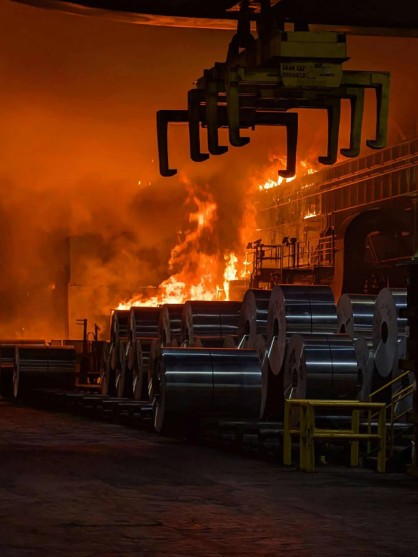Aluminum Interrupted: The Novelis Oswego Fire and Its Ripple Effects on U.S. Supply Chains
In the tightly wound machinery of North American manufacturing, few materials are as critical and as vulnerable as aluminum. On September 16, 2025, a fire at Novelis’ flagship rolling mill in Oswego, New York sent shockwaves through the automotive sector, abruptly halting production at a facility responsible for nearly 40% of the aluminum sheet used by U.S. automakers. The blaze, which destroyed the plant’s hot mill, has exposed not only the fragility of just-in-time supply chains but also the unintended consequences of tariff-driven trade policy. As automakers scramble to secure alternative sources, the incident has become a case study in strategic risk, policy misalignment, and the urgent need for resilient infrastructure.
Aluminum’s Industrial Backbone: What It Is and Why It Matters
Aluminum is more than a commodity it’s a strategic enabler of modern industry. Lightweight, corrosion-resistant, and highly formable, aluminum is essential to sectors ranging from automotive and aerospace to packaging and construction. In vehicles, aluminum alloys reduce weight, improve fuel efficiency, and enhance crash performance. These properties are especially vital in electric vehicles (EVs), where battery range and structural integrity depend on advanced materials.
The production of aluminum is a multi-stage process. It begins with the mining of bauxite ore, which contains hydrated aluminum oxide. Through the Bayer process, bauxite is refined into alumina a white powder. This alumina is then subjected to electrolysis via the Hall-Héroult process, producing molten aluminum. Finally, the metal is cast into ingots and rolled into sheets, rods, or extrusions. The Oswego facility specialized in rolling 6XXX-series automotive alloys, which require precise metallurgical control and rigorous qualification by original equipment manufacturers (OEMs). These sheets are not interchangeable with generic aluminum products, making substitution complex and time-consuming.
The Oswego Shutdown: A Strategic Choke Point
Novelis’ Oswego plant was not just another supplier it was a keystone in the North American automotive aluminum ecosystem. With an annual output of approximately 400,000 metric tons of rolled sheet, the facility served major automakers including Ford, Stellantis, Toyota, Hyundai, and Volkswagen. Ford, in particular, relied heavily on Oswego for its aluminum-bodied F-150 pickup, a flagship model and profit center.
The fire destroyed the hot mill, the heart of the plant’s rolling operation. Without it, the facility cannot produce the high-strength sheet required for automotive applications. Compounding the disruption, Novelis’ Kingston, Ontario cold mill which depends on Oswego’s hot band was also idled. The result is a sudden and severe supply vacuum that cannot be filled by domestic producers alone. Novelis has declared force majeure on shipments, and automakers are now facing production delays, cost escalations, and strategic uncertainty.
Tariffs and Trade Barriers: The Cost of Protectionism
In theory, Novelis could offset the shortfall by importing aluminum sheet from its facilities in Europe, Brazil, and South Korea. In practice, this solution is fraught with financial and regulatory obstacles. The United States imposes Section 232 tariffs on aluminum imports duties that can reach up to 50% on certain semi-fabricated products. These tariffs, originally enacted to protect domestic smelting capacity, now act as a barrier to emergency sourcing.
Even Canada, the largest foreign supplier of aluminum to the U.S., faces quota restrictions and tariff exposure. While Canadian smelters produce high-quality, low-carbon primary aluminum, they lack sufficient rolling infrastructure to produce automotive-grade sheet at scale. Retooling Canadian mills to meet OEM specifications involves lengthy qualification processes, alloy reconfiguration, and customer approvals none of which can be expedited overnight.
The result is a dilemma for automakers: pay steep tariffs to import aluminum or risk production delays and revenue loss. For Ford, Stellantis, and Toyota, this trade-off is not theoretical it is unfolding in real time. Dedicated teams are exploring every possible workaround, but the cost implications are significant. Analysts estimate Ford could face up to $800 million in earnings impact due to reduced fourth-quarter production. Novelis itself may lose $500 million in annual revenue, factoring in downtime and import costs.
Canada’s Role: Strategic Ally, Limited Relief
Canada produces over 3.3 million tonnes of primary aluminum annually, making it the fourth-largest global producer. Its smelters in Quebec and British Columbia rely on hydroelectric power, yielding the lowest carbon footprint among major suppliers. In 2024, Canada exported more than US$11 billion worth of aluminum to the United States, reinforcing its role as a strategic partner in North American manufacturing.
However, Canada’s ability to support the current crisis is constrained by infrastructure and policy. Most Canadian facilities focus on raw ingot production, not the rolling of specialized automotive sheet. The Kingston mill, Novelis’ key Canadian rolling site, is itself dependent on Oswego’s hot band and cannot operate independently. While Canada can supply feedstock to Novelis’ overseas mills, this adds logistical complexity and cost.
Efforts are underway to fast-track alloy qualification and expand rolling capacity, but these are medium-term solutions. In the short term, Canada remains a valuable partner but not a full substitute for Oswego’s output. The situation underscores the need for deeper U.S.-Canada integration in metals manufacturing, supported by aligned trade policy and infrastructure investment.
Strategic Outlook: Building Resilience Beyond Recovery
Novelis plans to restore Oswego’s hot mill by early 2026. A new plant in Alabama, slated to open next year, may help restore balance to the domestic supply chain. But the fire has accelerated calls for broader reform. Industry leaders and trade advisors are now advocating for a multi-pronged strategy to enhance resilience.
Key priorities include tariff reform, particularly the reevaluation of Section 232 duties to allow flexible sourcing during crises. Redundant capacity is also essential manufacturers must invest in backup infrastructure to prevent single-point failures. Finally, North American integration must be deepened, with coordinated investment in smelting, rolling, and recycling across the U.S. and Canada.
The Aluminum Association’s “Powering Up American Aluminum” roadmap offers a blueprint for this transformation. It calls for new smelters, expanded recycling, and trusted imports all of which require policy alignment and strategic funding. The Oswego fire has made clear that resilience is not just a technical challenge it is a policy imperative.
Conclusion: A Wake-Up Call for North American Industry
The Novelis Oswego fire is more than a localized incident it is a wake-up call for North American industry. It reveals how tariff structures, supply concentration, and qualification bottlenecks can converge into systemic risk. For automakers, the lesson is clear: diversification is no longer optional. For policymakers, it is time to balance protection with pragmatism. And for trade advisors, the moment demands bold, integrated solutions.
As the aluminum sector adapts, the Oswego fire may become a defining case study in supply chain fragility and strategic recovery. It is a reminder that resilience must be built not assumed and that policy must evolve to support the realities of modern manufacturing.

